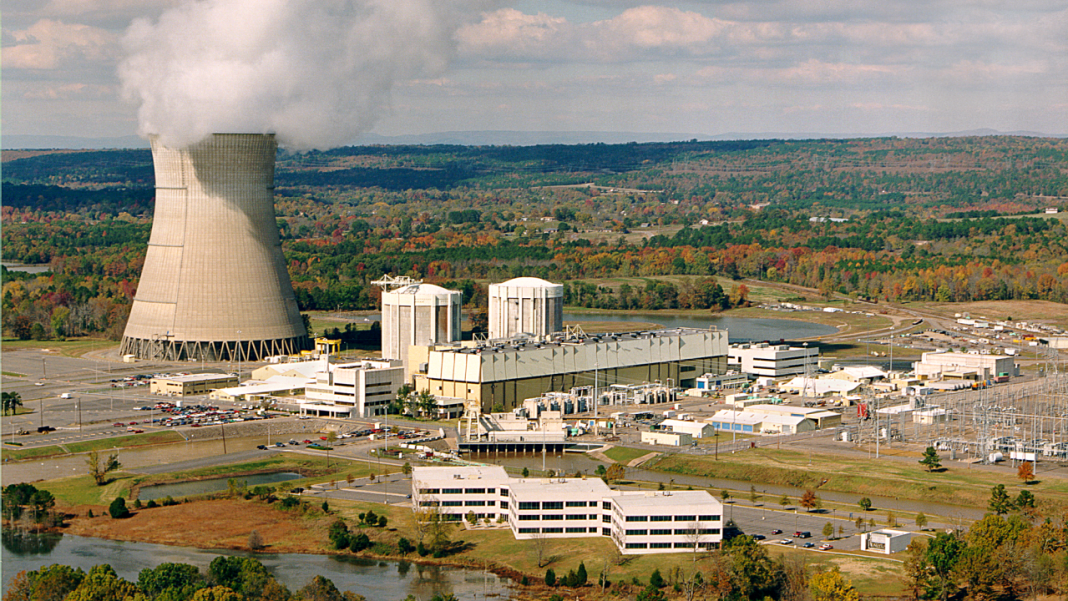By Dr. Curtis Varnell
A towering bank of steam rose from the distant tower, billowing into a cotton-candy cloud formation that can be seen from miles away. When young, my children called it the cloud-maker. The cooling tower at Arkansas Nuclear One is nearly 450 high and is the most notable feature of the electric generation plant owned by the Entergy corporation. Located near Russellville, Arkansas the two-units are the only source of nuclear electricity generation in the state.
During the 1960’s, electric power generation by nuclear plants was deemed both economic and safe and several plants were constructed across the U.S. Russellville was elated to be chosen to become the building site for the Arkansas plant. A multi-year and multi-billion-dollar endeavor, the first reactor went online commercially in December of 1974. It was followed by ANO-2 on March 26,1980.
The two reactors have the capability of producing enough energy to meet 56% of the total energy demand of Entergy Arkansas’s 700,000 customers. The plant was an economic boom for Pope county and Entergy hires a combined total of nearly 1,000 employees at the site.
The use of nuclear power has always engendered concern among people worldwide. The partial meltdown of unit 2 at Three Mile Island, Pennsylvania in 1979 created even more fear. That incident resulted in 140,000 people being evacuated and over 2 million people being exposed to minor amounts of radiation. Followed by other incidents at Chernobyl and in Japan, many question the use of nuclear energy. ANO has had a couple of incidents; a crane malfunction in 2013 resulted in one death and the injury of several other workers. In 2015, a reactor vessel head was found be defective and had to be replaced. In no known instance has there been an explosion or nuclear release danger to the public.
As a teacher intern in 1997, I worked the summer as a chemist at ANO. Each employee is required extensive training before ever allowed admittance into the plant. Every part of the reactor is color-coded to allow employees to know radiation and danger areas. Every employee is subjected to a full-body scan before hired and periodically afterward to determine if exposed to radiation (during my time there I absorbed more from the sun than from my work.) Access to the nuclear part of the facility requires a swipe card, a picture ID, a physical check matching your face with your ID, passing through a port similar to that at an airline, and then, to get into any portion of the building itself, you had to key in your personal number to access the door. Every person had to individually key themselves into each facility. Access to the control center- which reminded me of the bridge on Star Trek with its banks of computers and lights- requires even more security.
Every aspect of running the plant is checked constantly in the control room as well as at various stations throughout the plant. Every part has a safeguard. For every computer check, the chemist had to make rounds doing a physical check to verify and cross-check the same information. Environmental scientists make a daily check of trees, plants, fish, and animals in the zone around the facility.
The nuclear plant is not much different than a coal-burning plant except for the use of nuclear power to heat the water. The water heated by radiation is contained and never released to the lake or atmosphere. It simply passes through pipes and heats water in adjacent pipes which then generates power. The cloud making tower- standing inside of it is awesome -but it is nothing more than a huge sauna where the excess steam generated by one of the reactors is returned to the atmosphere.
Living near a nuclear generating plant has now become old hat. Locals are used to seeing the tower and occasionally hearing the sirens for nuclear practice evacuation. Recently, ANO operation license was extended by the Nuclear Regulatory Commission until 2034 for unit one and until 2036 for unit 2. By that time the cloud-maker will have been with us for fifty-years.







